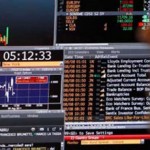Global stocks extended declines Tuesday

Global stocks extended declines Tuesday, taking European markets past a six month and pulling U.S. equity futures into the red, following a downbeat assessment of world economic growth from the International Monetary Fund and a renewed rise in U.S. government bond yields ahead of a three-day series of auctions from the Treasury that will add $230 billion to an already-stressed bond market.
The Tuesday Market Minute
- Global stocks continued to tumble Tuesday, following a downbeat assessment of world economic growth from the IMF and the ongoing rise of U.S. government bond yields and the dollar.
- Bond yields continue to rise, with benchmark 10-year Treasuries trading at 3.25% ahead of $230 billion in fresh supply this week, including 3-year, 10-year and 30-year paper.
- European stocks slides as the ongoing standoff between Italy and the EU over 2019 spending plans blunts sentiment and the IMF says regional growth will slow next year amid trade tensions and political uncertainty.
- U.S. equity futures are weaker, with the Dow looking at a 100 point opening bell decline while oil prices resume their march back to four-year highs as WTI rises to $75 a barrel.
Market Snapshot
Global stocks extended declines Tuesday, taking European markets past a six month and pulling U.S. equity futures into the red, following a downbeat assessment of world economic growth from the International Monetary Fund and a renewed rise in U.S. government bond yields ahead of a three-day series of auctions from the Treasury that will add $230 billion to an already-stressed bond market.
The IMF said trade tensions between Washington and Beijing, alongside tighter financing conditions in emerging markets and uncertainty in Europe, will weigh on growth this year and next, while the bump from fiscal stimulus in the United States will fade just as higher borrowing costs begin to crimp consumer demand in the red-hot U.S. economy.
“U.S. growth will decline once parts of its fiscal stimulus go into reverse,” said IMF chief economist Maurice Obstfeld . “Notwithstanding the present demand momentum, we have downgraded our 2019 U.S. growth forecast owing to the recently enacted tariffs on a wide range of imports from China and China’s retaliation.”
The Fund’s global growth assessment was trimmed by 2 percentage points to 3.7% for this year and next, while its World Economic Outlook update said U.S. growth will likely hit 2.7% next year, down from a previous assessment of 2.9%. China’s economy, the second largest in the world, will ease to 6.2% from a previous forecast of 6.4%. Both the U.S. and China assessments for 2018 were left unchanged and 2.9% and 6.6% respectively, with the Fund saying that tit-for-tat tariffs, currently applied to around $300 billion worth of goods, likely won’t hit growth metrics until 2019.
European stocks accelerated their declines into the mid-day break, with the Stoxx 600 falling 0.6% by early afternoon in Frankfurt as benchmarks around the region notched similar percentage gains and Germany’s DAX index traded firmly south of the 12,000 point threshold. Italy’s FTSE MIB was weaker still, however, falling 0.8% as the government’s Economy Minister, Giovanni Tria, addressed lawmakers in Rome and warned of the implications from creditors if bond yields continue to rise.
The Bank of Italy also warned that servicing the adding billions in deficit spending the government wants to add to the nation’s already-staggering €2.3 trillion debt pile is ” not insignificant … “the danger of triggering a vicious circle … with repercussions on the real economy, is always present.”
On the other side of the Atlantic, U.S. Treasury yields resumed their own increase, as markets prepared to re-open after yesterday’s Columbus Day holiday, with benchmark 10-year notes rising to 3.25% for only the second time since 2011 as the U.S. dollar index continued its march back to its 10-month high and gained 0.34% to trade at 96.08 against a basket of six global currencies.
U.S. equity futures, however, were pulled lower, with contracts tied to the Dow Jones Industrial Average suggesting a 112-point pullback at the opening bell while those linked the S&P 500 were indicating an 13 point decline for the broader benchmark. Nasdaq Composite futures were marked 32 points into the red.
The U.S. Treasury will kick off a holiday-shortened schedule of bond sales Tuesday that will see $230 billion in new paper find their way into portfolios this week — including $74 billion in 3-year, 10-year and 30-year bonds — that could provide one of the sternest tests yet to a market that appears ready to either stretch benchmark 10-year yields to 3.6% and beyond in the face of accelerating inflation or retreat to 3% amid questions over the pace of global economic growth and the spillover impact from the ongoing U.S.-China trade war.
Global oil prices were also active in the overnight session, with crude prices rising for a second consecutive session, as investors digested news that looming sanctions on Iranian exports were starting to blunt supply from one of OPEC’s key suppliers — which produces around 3% of total global output — and were offsetting concerns that slowing economic growth would trim overall demand.
Brent crude contracts for December delivery, the global benchmark, were seen 59 cents lower from their Monday close in New York and changing hands at $84.50 per barrel while WTI contracts for November delivery, which are more tightly liked to U.S gas prices, were seen 59 cents higher at $74.76 per barrel.
Source: TheStreet





























